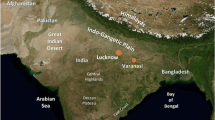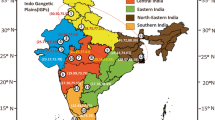Abstract
This study aims to predict monthly columnar ozone in Peninsular Malaysia based on concentrations of several atmospheric gases. Data pertaining to five atmospheric gases (CO2, O3, CH4, NO2, and H2O vapor) were retrieved by satellite scanning imaging absorption spectrometry for atmospheric chartography from 2003 to 2008 and used to develop a model to predict columnar ozone in Peninsular Malaysia. Analyses of the northeast monsoon (NEM) and the southwest monsoon (SWM) seasons were conducted separately. Based on the Pearson correlation matrices, columnar ozone was negatively correlated with H2O vapor but positively correlated with CO2 and NO2 during both the NEM and SWM seasons from 2003 to 2008. This result was expected because NO2 is a precursor of ozone. Therefore, an increase in columnar ozone concentration is associated with an increase in NO2 but a decrease in H2O vapor. In the NEM season, columnar ozone was negatively correlated with H2O (–0.847), NO2 (0.754), and CO2 (0.477); columnar ozone was also negatively but weakly correlated with CH4 (–0.035). In the SWM season, columnar ozone was highly positively correlated with NO2 (0.855), CO2 (0.572), and CH4 (0.321) and also highly negatively correlated with H2O (–0.832). Both multiple regression and principal component analyses were used to predict the columnar ozone value in Peninsular Malaysia. We obtained the best-fitting regression equations for the columnar ozone data using four independent variables. Our results show approximately the same R value (≈ 0.83) for both the NEM and SWM seasons.
Similar content being viewed by others
References
Abdul-Wahab S A, Bakheit C S, Al-Alawi S M (2005). Principle component and multiple regression analysis in modelling of groundlevel ozone and factors affecting its concentrations. Environ Model Softw, 20(10): 1263–1271
Ahammed Y N, Reddy R R, Gopal K R, Narasimhulu K, Basha D B, Reddy L S S, Rao T V R (2006). Seasonal variation of the surface ozone and its precursor gases during 2001–2003, measured at Anantapur (14.628N), a semi-arid site in India. Atmos Res, 80(2–3): 151–164
Al-Alawi S M, Abdul-Wahab S A, Bakheit C S (2008). Combining principal component regression and artificial neural networks for more accurate predictions of ground-level ozone. Environ Model Softw, 20: 1263–1271
Azid A, Juahir H, Toriman M E, Kamarudin M K A, Saudi A S M, Hasnam C N C, Aziz N A A, Azaman F, LatifMT, Zainuddin S FM, Osman M R, Yamin M (2014). Prediction of the level of air pollution using principal component analysis and artificial neural network techniques: a case study in Malaysia. Water Air Soil Pollut, 225(8): 2063
Baker D J, Richards G, Grainger A, Gonzalez P, Brown S, Defries R, Held A, Kellndorfer J, Ndunda P, Ojima D, Skrovseth P E, Souza C Jr, Stolle F (2010). Achieving forest carbon information with higher certainty: a five-part plan. Environ Sci Policy, 13(3): 249–260
Bian J, Gettelman A, Chen H, Pan L (2007). Validation of satellite ozone profile retrievals using Bei**g ozonesonde data. J Geophys Res, 112 (D6): D06305
Bracher A, Lamsal L N, Weber M, Bramstedt K, Coldewey-Egbers M, Burrows J P (2005). Global satellite validation of SCIAMACHY O3 columns with GOME WFMDOAS. Atmos Chem Phys, 5(9): 2357–2368
Buchwitz M, de Beek R, Burrows J P, Bovensmann H, Warneke T, Notholt J, Meirink J F, Goede A P H, Bergamaschi P, Körner S, Heimann M, Schulz A (2005). Atmospheric methane and carbon dioxide from SCIAMACHY satellite data: initial comparison with chemistry and transport models. Atmos Chem Phys, 5(4): 941–962
Coldewey-Egbers M, Weber M, Lamsal L N, de Beek R, Buchwitz M, Burrows J P (2005). Total ozone retrieval from GOME UV spectral data using the weighting function DOAS approach. Atmos Chem Phys, 5(4): 1015–1025
Dueñas C, Fernández M C, Cañete S, Carretero J, Liger E (2004). Analyses of ozone in urban and rural sites in Málaga (Spain). Chemosphere, 56(6): 631–639
Johnson C E, Stevenson D S, Collins W J, Derwent R G (2002). Interannual variability in methane growth rate simulated with a coupled Ocean-Atmosphere-Chemistry model. Geophys Res Lett, 29 (19): doi: 10.1029/2002GL015269
Lengyel A, Héberger K, Paksy L, Bánhidi O, Rajkó R (2004). Prediction of ozone concentration in ambient air using multivariate methods. Chemosphere, 57(8): 889–896
Lin W, Xu X, Zhang X, Tang J (2008). Contributions of pollutants from North China Plain to surface ozone at the Shangdianzi GAW Station. Atmos Chem Phys, 8(19): 5889–5898
Mieruch S, Noël S, Bovensmann H, Burrows J P (2008). Analysis of global water vapour trends from satellite measurements in the visible spectral range. Atmos Chem Phys, 8(3): 491–504
Omar D (2009). Urban form and sustainability of a hot humid city of Kuala Lumpur. J Soc Sci, 8: 353–359
Pochanart P, Kreasuwun J, Sukasem P, Geeratithadaniyom W, Tabucanon M S, Hirokawa J, Kajii Y, Akimoto H (2001). Tropical tropospheric ozone observed in Thailand. Atmos Environ, 35(15): 2657–2668
Rajab J M, Mat Jafri M Z, Lim H S (2013). Combining multiple regression and principal component analysis for accurate predictions for column ozone in Peninsular Malaysia. Atmos Environ, 71: 36–43
Reddy B S K, Kumar K R, Balakrishnaiah G, Gopal K R, Reddy R R, Sivakumar V, Lingaswamy A P, Arafath S Md, Umadevi K, Kumari S P, Ahammed Y N, Lal S (2012). Analysis of diurnal and seasonal behaviour of surface ozone and its precursor (NOx) at a semi-arid rural site in Southern India. Aerosol Air Qual Res, 12: 1081–1094
Richter A, Burrows J P, Nüß H, Granier C, Niemeier U (2005). Increase in tropospheric nitrogen dioxide over China observed from space. Nature, 437(7055): 129–132
Richter A, Eyring V, Burrows J P, Bovensmann H, Lauer A, Sierk B, Crutzen P J (2004). Satellite measurements of NO2 from international ship** emissions. Geophys Res Lett, 31(23): L23110
Schneising O, Buchwitz M, Burrows J P, Bovensmann H, Bergamaschi P, Peters W(2008a). Three years of greenhouse gas column averaged dry air mole fractions retrieved from satellite-part 2: methane. Atmos Chem Phys, 8(3): 8273–8326
Schneising O, Buchwitz M, Burrows J P, Bovensmann H, Reuter M, Notholt J, Macatangay R, Warneke T (2008b). Three years of greenhouse gas column-averaged dry air mole fractions retrieved from satellite–Part 1: carbon dioxide. Atmos Chem Phys, 8(14): 3827–3853
Statheropoulos M, Vassiliadis N, Pappa A (1998). Principle component and canocical correlation analysis for examining air pollution and meteorological data. Atmos Environ, 32(6): 1087–1095
Stephens B B, Gurney K R, Tans P P, Sweeney C, Peters W, Bruhwiler L, Ciais P, Ramonet M, Bousquet P, Nakazawa T, Aoki S, Machida T, Inoue G, Vinnichenko N, Lloyd J, Jordan A, Heimann M, Shibistova O, Langenfelds R L, Steele L P, Francey R J, Denning A S (2007). Weak northern and strong tropical land carbon uptake from vertical profiles of atmospheric CO2. Science, 316(5832): 1732–1735
Tan K C, Lim H S, Mat Jafri M Z (2012a). Total ozone column distribution over Peninsular Malaysia from Scanning Imaging Absorption Spectrometer for Atmospheric Cartography (SCIAMACHY). Proceeding SPIE 8538 Earth Resources and Environmental Remote Sensing/GISApplications III, 85380Y
Tan K C, Lim H S, Mat Jafri M Z (2012b). Satellite observation distribution of atmospheric ozone over Peninsular Malaysia from SCIAMACHY. International Coference on Control System, Computing and Engineering (ICCSCE 2012), 238–243
Tan K C, Lim H S, Mat Jafri M Z (2013). Relationship between ozone and their air pollutants in Peninsular Malaysia for 2003 retrieved from SCIAMACHY. AIP Conf Proc, 1528: 151–156
Tan K C, Lim H S, Mat Jafri M Z (2014a). Analysis of total column ozone in Peninsular Malaysia retrieved from SCIAMACHY. Atmos Pollut Res, 5(1): 42–51
Tan K C, Lim H S, Mat Jafri M Z (2014b). Multiple regression analysis in modeling of columnar ozone in Peninsular Malaysia. Environ Sci Pollut Res Int, 21(12): 7567–7577
Tan K C, Lim H S, Mat Jafri M Z. (2012c). Total ozone column distribution over Peninsular Malaysia from scanning imaging absorption spectrometer for atmospheric cartography (SCIAMACHY). Proc. SPIE 8538 Earth Resources and Environmental Remote Sensing/GISApplications III, 85380Y (October 25, 2012)
Tian W, Chipperfield M P, Lü D (2009). Impact of increasing stratospheric water vapor on ozone depletion and temperature change. Adv Atmos Sci, 26(3): 423–437
Toh Y Y, Lim S F, Von Glasow R (2013). The influence of meteorological factors and biomass burning on surface ozone concentrations at Tanah Rata, Malaysia. Atmos Environ, 70: 435–446
Vaidya O C, Howell G D, Leger D A (2000). Evaluation of the distribution of mercury in lakes in Nova Scotia and Newfoundland. Water Air Soil Pollut, 117(1/4): 353–369
Vingarzan R (2004). A review of surface ozone background levels and trends. Atmos Environ, 38(21): 3431–3442
Wang Y S, Zhou L, Wang M X, Zheng X H (2001). Trends of atmospheric methane in Bei**g. Chemosphere, Glob Chang Sci, 3 (1): 65–71
Wu H W Y, Chan L Y (2001). Surface ozone trends in Hong Kong in 1985–1995. Environ Int, 26(4): 213–222
Yonemura S, Tsuruta H, Kawashima S, Sudo S, Leong C P, Lim S F, Zubaidi J, Masayasu H (2002). Tropospheric ozone climatology over Peninsular Malaysia from 1992 to 1999. J Geophys Res, 107(D15): 4229
Author information
Authors and Affiliations
Corresponding author
Additional information
Tan Kok Chooi is a Senior Lecturer at the School of Physics, Universiti Sains Malaysia. He obtained his Ph.D in image processing from Universiti Sains Malaysia. His research interests cover the field of remote sensing applications and environmental monitoring, such as land use/land cover changes, land surface properties, and image classification. Currently, his research focuses on the environmental remote sensing, atmospheric chemistry and physics.
Lim Hwee San is an Associate Professor of Geophysics and Remote Sensing at the School of Physics, Universiti Sains Malaysia. He obtained his Ph.D from Universiti Sains Malaysia in environmental remote sensing. His research interests lie generally in the field of optical remote sensing-both passive and active-and digital image processing, particularly as it applies to spectral image data. In both cases, the primary applications are water quality monitoring, air quality monitoring, land cover/change detection, land surface properties and digital images classification. He also interested in modelling of the optical properties of atmospheric aerosols. His current effort focus on the applications of ground based LIDAR and satellite based LIDAR (e.g., CALIPSO, AIRS) data for air pollution and green house effects study.
Mohd. Zubir Mat Jafri is a Professor of Optical Sensing and Remote Sensing at the School of Physics, Universiti Sains Malaysia. He obtained his Ph.D from Universiti College of Swansea, Wales, UK, in digital image processing. He has more than twenty years teaching and research experience in the area of physics, optical communication, digital image processing, electronics and microprocessor technology.
Rights and permissions
About this article
Cite this article
Tan, K.C., Lim, H.S. & Mat Jafri, M.Z. A statistical model to predict total column ozone in Peninsular Malaysia. Front. Earth Sci. 10, 63–73 (2016). https://doi.org/10.1007/s11707-015-0521-8
Received:
Accepted:
Published:
Issue Date:
DOI: https://doi.org/10.1007/s11707-015-0521-8




